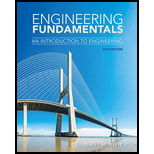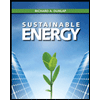
Concept explainers
Investigate the operation of various turbines and explain the operation of steam turbines, hydraulic turbines, gas turbines, and wind turbines.
Explanation of Solution
Turbine:
A turbine is also known as rotary engine that transforms the rotational energy from a fluid or air into a usable energy or work.
The turbine contains a generator, a shaft, and blades. The blade act as a barrier for fluid or air, when the blade moves the energy from the water or air is transferred to the rotor. When the rotor starts to rotate the shaft also rotates and transforms the
Impulse turbine:
Impulse turbine changes the flow path of high velocity fluid. The turbine spins and leaves the kinetic energy from the fluid flow as a result of the impulse. The pressure of the blades does not alter. The total pressure drop takes place in the stationary blades for the steam or gas turbine. The stationary blades is the part which takes place the total pressure drop in the steam or gas turbine.
The fluid pressure head is reformed to velocity head by accelerating the fluid with a nozzle. No pressure casement is required for impulse turbine. The Pelton wheels use the impulse turbine concept exclusively.
Reaction turbine:
The reaction turbine functions are based on the Newton’s third law of motion. The torque developed due to the turbine response to the fluid pressure. The pressure casement is essential for the turbine.
The turbine nozzles are united to the rotor. The Francis turbine and steam turbines are use the concept of reaction turbine. When the fluid leaving through the nozzles, it produces a reaction force on the pipes due to acceleration of fluid. It causes the rotor to change in the direction against to the direction of fluid. Steam turbines and Francis turbine are used by the concept of reaction turbine.
Operation of steam turbine:
The higher amount of mechanical power is produced by the steam turbine applying the less amount of steam. The wheels and blades are attached to the steam turbine rotor. The turbine blade extracts the energy from the steam. It is meant for the electricity production in the thermal power plants. The primary type of steam turbine is the condensing steam turbine.
Operation of hydraulic turbine:
The hydraulic turbine transforms the kinetic energy of the falling water into mechanical energy of rotation. It is used in hydraulic power plants. The modern hydraulic turbines are a form of fluid dynamic machinery of the jet and vane type operating on the principle of impulse or reaction turbine.
Operation of gas turbine:
In gas turbine the air is used as a working fluid. It contains three main components they are downstream turbine on the shaft, upstream rotating gas compressor, and a combustion chamber in the midst of the compressor and the shaft.
The compressor pulls the air into the engine, and push in to the ‘combustion chamber’. It creates the larger amount of pressure and temperature and expands through the turbine section, then the electricity has produced owing to the spinning of generator.
Operation of wind turbine:
Wind turbine works on the principle by which the wind is used to generate mechanical power or electricity. The propellers or blades get rotation while the wind energy strikes on the blades around the rotor. The shaft is connected with rotor and it induce the generator to produce electricity.
Conclusion:
Thus, the operation of steam turbines, hydraulic turbines, gas turbines, and wind turbines is explained.
Want to see more full solutions like this?
Chapter 4 Solutions
Engineering Fundamentals: An Introduction to Engineering
- Determine the design resistance to transverse force F,Rdarrow_forwardAs a structural engineer, your task is to design an optimum section that has sufficient resistance to the applied loading for the primary beam proposed in Figure 1. A UB in grade S275 steel is required for the unrestraint beam to carry the ultimate loads over the given span. Choose an optimumUB section and justify your selection. You are required to submit a design analysis by considering bending, shear, transverse force, and deflection checking for the selected member based on Eurocode 3 and the assumption of support condition and loading must be clearly stated. P=15 kN. a 2 m. b=3m ·L· ·b. Figure 1 Simply supported steel beamarrow_forwardWhy is it important to establish logical relationships between tasks when developing a construction schedule?arrow_forward
- For the gravity concrete dam shown in the figure, the following data are available: - Unit weight of concrete (Yeone) = 2.4 ton/m³ Neglect( Wave pressure, silt pressure, ice force and earth quake force) -0.65, (Ywater) 1 ton/m³ Find factor of safety against sliding and overturning (F.Said & F.Sover), If heel and toe stresses (Pais & Pmas) are 57.17ton/m2 and 84.53 ton/m² respectively. w.s.l 83m 10m 80m 8m Solve on paper step by step with sketcharrow_forwardWhy is proper planning important when developing a baseline construction project schedule?arrow_forwardDetermine the minimum possible surface area of a secondary clarifier treating activated sludge with a design influent flow rate (Q) of 1,000 m³/d, a return activated sludge (RAS) recycling ratio of 25%, and a mixed liquor total suspended solids (MLSS) concentration of 4,000 mg/L, if the overflow rate must be less than 33 m/d and the solids loading rate must be less than 250 kg/m²/d. Express your answer in m² and round up to the next integer.arrow_forward
- Estimate the required air flow rate for the new activated sludge plant at Pea Ridge (Problems 23-223-723-10, and 23-13). The flow rate is 8,450 m³/day, the concentration of bCOD going into the system (So) is 137 mg/L, the concentration of bCOD leaving the system (S) is 16.3 mg/L, and the mass of cells produced per day (Pxvss) is 277.4 kg/d. Use the following assumptions to estimate the required air flow rate: . Clean water correction, a = 0.50 . Salinity correction, B = 0.95 Fouling factor = 0.9 Wastewater temperature = 12°C Atmospheric pressure = 101.325 kPa .Elevation 500 m . Depth of aerator = 5.6 m Operating DO 2.0 mg/L Percent oxygen leaving aeration tank - 19% ■ Manufacturer's SOTR = 535 kg/d Manufacturer's air flow rate at standard conditions 50 m³/d - aerator Express your answer with the units of m³/d and round to the nearest integer.arrow_forwardDetermine the required solids retention time (SRT) of a completely mixed activated sludge aeration tank for a conventional activated sludge system treating a design flow rate of 34,560 m³/d, where the effluent standards are 30.0 mg/L for BODs and 30.0 mg/L for total suspended solids (TSS). Assume that the BOD5 of the effluent TSS is 70% of the TSS concentration. Assume the BODs concentration leaving the primary clarifier is 128 mg/L that the MLVSS concentration (X₂) is 2,500 mg/L. Assume the following values for the growth constants: Ks 100 mg/L BODS ⚫ Hm - 2.5 d 1 kd = 0.050 d 1 Y = 0.50 mg VSS/mg BODs removed Express your answer in days and round to the nearest 0.1.arrow_forwardQ1: Figure below shows loaded beam with its cross-section area, (A) Draw shear force and bending moment diagrams, stating the main values, (B) Find central slope and deflection, (C) Sketch the distribution of shear stress at left support, (D) Find maximum tensile and compressive bending stresses set up in beam at right support. E-205GN/m² P1 P2 P3 W1 W2 Lin Lin # A Length in (m) and loads in kN 3a a 2a 2a (Cross-section area, All dimensions in (mm))arrow_forward
- Estimate the mass of oxygen to be supplied for a new activated sludge plant at Pea Ridge to treat a flow rate of 8,450 m³/day. Assume that the concentration of bCOD going into the system (So) is 137 mg/L, that the bCOD leaving the system (S) is 16.3 mg/L, and that the mass of cells produced per day (Pxvss) is 277.4 kg/d. Express your answer in kg/day and round to the nearest integer.arrow_forward*10-4. Determine the internal moments at the supports A, B, and C, then draw the moment diagram. Assume A is pinned, and B and C are rollers. El is constant. 3 k/ft 8 ft- 8 ft -4 ft-arrow_forwardQ2: Determine the change in dimensions in each section of the bar shown in figure. The portion AB is circular section and portion BC is rectangular section. E=115GN/m², v=0.33. L1 L2 P2+ P2 B Q3: A block is subjected to the stresses as shown in figure, find: principal stresses, shear stress with their directions and the normal and shear stresses on a plane inclined at 0. All stresses in MPa. (Confirm your answer by means of Mohr's stress circle). Txy 30 Note: (1) For all questions the student can choose any values of P1, P2, P3, W1, W2, a, σ (MPa), Txy (MPa), 0°, length and the dimensions of cross section area.arrow_forward
 Engineering Fundamentals: An Introduction to Engi...Civil EngineeringISBN:9781305084766Author:Saeed MoaveniPublisher:Cengage Learning
Engineering Fundamentals: An Introduction to Engi...Civil EngineeringISBN:9781305084766Author:Saeed MoaveniPublisher:Cengage Learning
 Fundamentals Of Construction EstimatingCivil EngineeringISBN:9781337399395Author:Pratt, David J.Publisher:Cengage,
Fundamentals Of Construction EstimatingCivil EngineeringISBN:9781337399395Author:Pratt, David J.Publisher:Cengage, Sustainable EnergyCivil EngineeringISBN:9781133108689Author:Richard A. DunlapPublisher:Cengage Learning
Sustainable EnergyCivil EngineeringISBN:9781133108689Author:Richard A. DunlapPublisher:Cengage Learning



